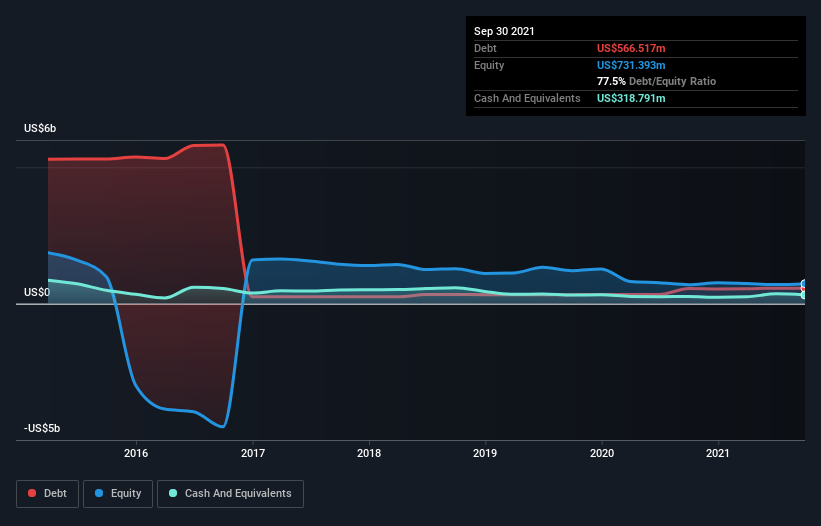Howard Marks put it nicely when he said that, rather than worrying about share price volatility, 'The possibility of permanent loss is the risk I worry about... and every practical investor I know worries about.' It's only natural to consider a company's balance sheet when you examine how risky it is, since debt is often involved when a business collapses. As with many other companies Frontera Energy Corporation (TSE:FEC) makes use of debt. But should shareholders be worried about its use of debt?
What Risk Does Debt Bring?
Debt and other liabilities become risky for a business when it cannot easily fulfill those obligations, either with free cash flow or by raising capital at an attractive price. In the worst case scenario, a company can go bankrupt if it cannot pay its creditors. However, a more frequent (but still costly) occurrence is where a company must issue shares at bargain-basement prices, permanently diluting shareholders, just to shore up its balance sheet. Of course, the upside of debt is that it often represents cheap capital, especially when it replaces dilution in a company with the ability to reinvest at high rates of return. The first step when considering a company's debt levels is to consider its cash and debt together.
View our latest analysis for Frontera Energy
What Is Frontera Energy's Net Debt?
The chart below, which you can click on for greater detail, shows that Frontera Energy had US$566.5m in debt in September 2021; about the same as the year before. However, it also had US$318.8m in cash, and so its net debt is US$247.7m.

How Strong Is Frontera Energy's Balance Sheet?
Zooming in on the latest balance sheet data, we can see that Frontera Energy had liabilities of US$729.2m due within 12 months and liabilities of US$585.0m due beyond that. On the other hand, it had cash of US$318.8m and US$143.1m worth of receivables due within a year. So its liabilities outweigh the sum of its cash and (near-term) receivables by US$852.2m.
This is a mountain of leverage relative to its market capitalization of US$957.5m. Should its lenders demand that it shore up the balance sheet, shareholders would likely face severe dilution. There's no doubt that we learn most about debt from the balance sheet. But it is future earnings, more than anything, that will determine Frontera Energy's ability to maintain a healthy balance sheet going forward. So if you want to see what the professionals think, you might find this free report on analyst profit forecasts to be interesting.
Over 12 months, Frontera Energy made a loss at the EBIT level, and saw its revenue drop to US$769m, which is a fall of 6.5%. We would much prefer see growth.
Caveat Emptor
Importantly, Frontera Energy had an earnings before interest and tax (EBIT) loss over the last year. Indeed, it lost US$53m at the EBIT level. When we look at that and recall the liabilities on its balance sheet, relative to cash, it seems unwise to us for the company to have any debt. Quite frankly we think the balance sheet is far from match-fit, although it could be improved with time. On the bright side, we note that trailing twelve month EBIT is worse than the free cash flow of US$65m and the profit of US$47m. So one might argue that there's still a chance it can get things on the right track. The balance sheet is clearly the area to focus on when you are analysing debt. However, not all investment risk resides within the balance sheet - far from it. These risks can be hard to spot. Every company has them, and we've spotted 2 warning signs for Frontera Energy you should know about.
If you're interested in investing in businesses that can grow profits without the burden of debt, then check out this free list of growing businesses that have net cash on the balance sheet.
New: AI Stock Screener & Alerts
Our new AI Stock Screener scans the market every day to uncover opportunities.
• Dividend Powerhouses (3%+ Yield)
• Undervalued Small Caps with Insider Buying
• High growth Tech and AI Companies
Or build your own from over 50 metrics.
Have feedback on this article? Concerned about the content? Get in touch with us directly. Alternatively, email editorial-team (at) simplywallst.com.
This article by Simply Wall St is general in nature. We provide commentary based on historical data and analyst forecasts only using an unbiased methodology and our articles are not intended to be financial advice. It does not constitute a recommendation to buy or sell any stock, and does not take account of your objectives, or your financial situation. We aim to bring you long-term focused analysis driven by fundamental data. Note that our analysis may not factor in the latest price-sensitive company announcements or qualitative material. Simply Wall St has no position in any stocks mentioned.
About TSX:FEC
Frontera Energy
Engages in the exploration, development, production, transportation, storage, and sale of oil and natural gas in South America.
Good value with adequate balance sheet.
Similar Companies
Market Insights
Community Narratives



